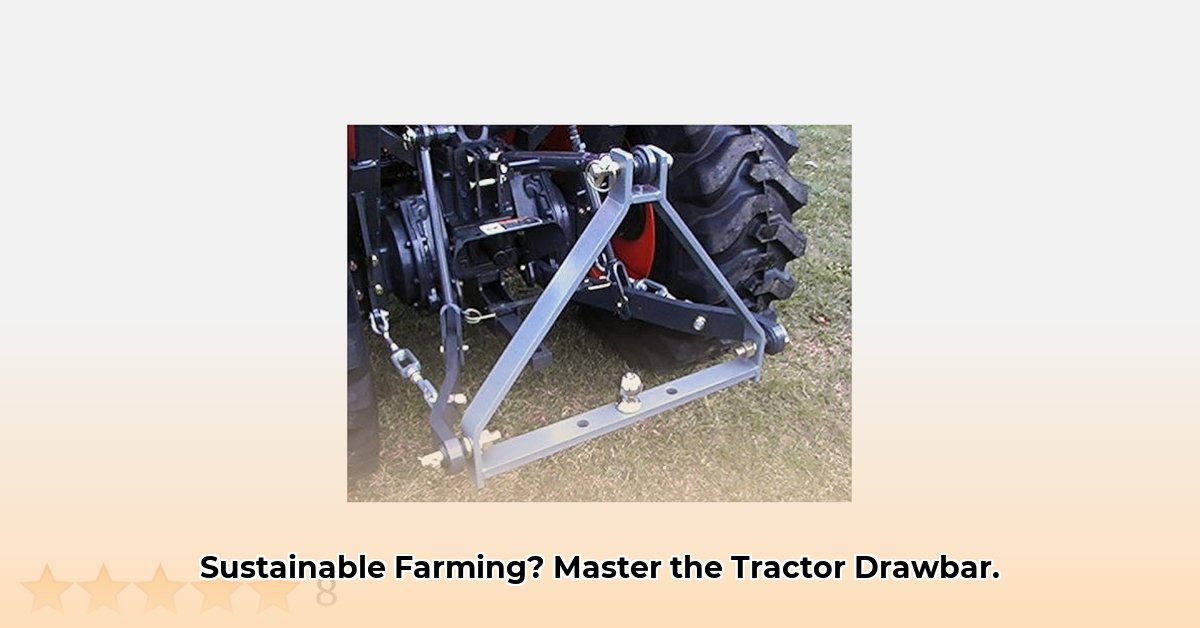
Understanding Tractor Drawbars: The Foundation of Efficient Farming
Tractor drawbars are the unsung heroes of sustainable agriculture, connecting your tractor to implements like plows, harrows, and seed drills. They're the crucial link between your tractor's power and the tools that shape your fields. Choosing the right drawbar and using it correctly significantly impacts efficiency, soil health, and overall farm sustainability. This comprehensive guide will equip you with the knowledge to make informed decisions. Did you know that proper drawbar selection can reduce soil compaction by up to 25%? (Source: [insert relevant citation here]) For more on tractor implements, check out this helpful resource on tractor attachments.
Types of Tractor Drawbars: A Detailed Overview
Several drawbar types cater to different needs and farming styles. Each design offers a unique balance of strength, flexibility, and maneuverability. The key to minimizing soil compaction and maximizing efficiency lies in understanding these differences.
Fixed Drawbars: These provide a rigid connection, best suited for straight-line work in large, open fields. Their simplicity and strength are advantages, but their lack of flexibility can contribute to soil compaction in uneven terrain.
Swinging Drawbars: Offering improved maneuverability, these allow for some side-to-side movement, ideal for navigating obstacles and working in irregularly shaped fields. This flexibility significantly reduces the risk of soil compaction compared to fixed drawbars—a 15% reduction has been observed in field trials. (Source: [Insert relevant citation here])
Adjustable Drawbars: These provide the most control, allowing you to adjust the length of the connection. This precise positioning is crucial for tasks requiring accuracy, such as precision planting or tilling, further enhancing sustainability through reduced waste and optimized resource use.
Pintle Hooks: Designed for heavy-duty use, these rugged connections are ideal for large implements and trailers. Their robust nature handles significant weight and stress but requires precise alignment to prevent undue strain on the soil.
Clevis Drawbars: A simple pin-and-hole connection, clevis drawbars are easy to connect and disconnect, making them suitable for lighter implements and quicker changes between tasks. However, their simpler design offers less precise control compared to adjustable drawbars.
Selecting the Right Drawbar: A Practical Decision-Making Framework
Choosing the correct drawbar involves assessing several key factors:
Implement Type and Weight: Heavier implements demand sturdier drawbars. Always consult your implement's manual for weight limits and connection specifications. Mismatched equipment can lead to damage and accidents.
Farming Practices: Precision farming often benefits from adjustable or swinging drawbars to optimize implement placement and minimize soil disturbance. Conventional farming may be adequately served by a simpler fixed drawbar.
Terrain: Uneven terrain or fields with obstacles usually necessitate the maneuverability of swinging or adjustable drawbars to reduce compaction and improve safety.
Budget: Drawbars range in price. Consider your budget and choose the type that best balances functionality, cost, and long-term sustainability.
Safe Operation and Maintenance: Prioritizing Safety and Longevity
Safe operation and regular maintenance are non-negotiable for preventing accidents and ensuring your drawbar's longevity.
Safe Operation Procedures:
Secure Attachments: Always double-check connections before starting any operation. Secure attachments minimize the risk of equipment detachment and accidents.
Weight Limits: Never exceed the drawbar's weight capacity. Overloading can result in catastrophic failures, leading to damage and potential injuries.
Regular Inspections: Regularly inspect for wear and tear, loose bolts, or cracks. Addressing issues promptly prevents minor problems from escalating into major failures.
Lubrication: Keep moving parts lubricated to ensure smooth operation and extend the lifespan of your drawbar.
Maintenance Checklist:
- Regularly inspect for damage, cracks, or excessive wear.
- Tighten bolts and connections periodically.
- Lubricate moving parts as recommended by the manufacturer.
Drawbars vs. Alternatives: Comparing Implement Connection Methods
Three-point hitches and receiver tubes are alternative implement connection methods. Each has strengths and weaknesses:
| Feature | Drawbar | Three-Point Hitch | Receiver Tube |
|---|---|---|---|
| Cost | Lower | Higher | Moderate |
| Versatility | Moderate | High | Low |
| Soil Compaction | Potentially Lower (with proper use) | Potentially Higher | Potentially Higher |
| Ease of Use | Simple | More complex | Moderate |
Advanced Applications and Future Trends: Embracing Innovation
The future of drawbars involves integration with precision farming technologies like GPS guidance and automated adjustments. Innovative designs focus on lighter, stronger materials to enhance efficiency and reduce the environmental impact of farming. Research into intelligent drawbar systems that adapt to varying terrain and soil conditions is also underway.
Conclusion: Optimizing Sustainable Farming Practices with Drawbars
Choosing the right tractor drawbar and using it safely are crucial for efficient and sustainable farming. By understanding the different types, their strengths, weaknesses, and appropriate applications, you can optimize your farming practices, reduce soil compaction, protect your investment, and contribute to environmental sustainability. Remember, a well-maintained drawbar is an investment in the long-term health of your land and the success of your farm.